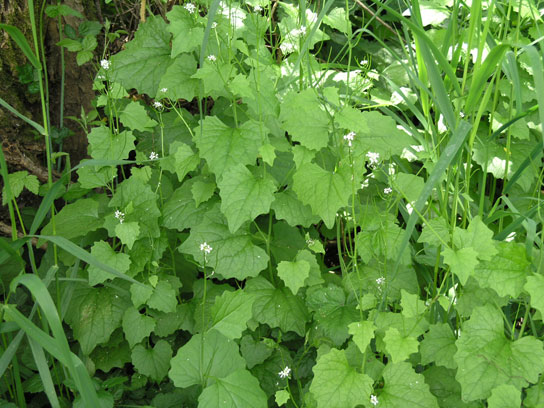
Plant Description
- Leaves have a strong onion or garlic odor when crushed
- Small white flowers with four petals bloom in early spring
- Biennial herb that overwinters as a rosette with kidney-shaped leaves
- Grows to about 3 feet tall in its second year, as it gets ready to produce flowers
- Small root system
- Grows in dense shade or full sun in a variety of soils
- Scientific Name: Alliaria petiolata
History
Garlic mustard is native to Europe and was introduced to the U.S. in the 1800s for medicinal and culinary use. It is widespread throughout the eastern U.S. but it is relatively new to the northwest. It was first identified in Seattle, WA in 1999.
Spread
Each plant can produce hundreds of tiny seeds that are easily spread by animals and people. The seeds are viable in the soil for several years.
Ecological Threats
Garlic mustard can completely cover the forest understory where it will outcompete tree seedlings and other native plants. This plant is allelopathic, which means it produces chemicals that inhibit the growth of our native plants. Eventually the forest canopy will be replaced by a garlic mustard monoculture.
Control
Mechanical: Garlic mustard can be pulled by hand in the winter and early spring, before or during flowering. All plants must be bagged and put into the trash, as they can continue to produce seed even after they are pulled. This method can be effective if all plants are pulled before they set seed.
Chemical: Garlic mustard can be sprayed with the appropriate herbicides in the late winter and early spring, before flowering. Multiple years of control may be necessary until the seed bank is exhausted.
Contact our Invasive Species Coordinator by e-mail at [email protected] or call 360-992-8787 for more information on garlic mustard control.
Current Nationwide and Statewide Distribution
See USDA PLANTS database maps.
Garlic mustard is considered a Washington State Class A noxious weed and control is recommended throughout the state.
Local Watershed Distribution
Garlic mustard has been found in the lower Salmon Creek watershed, including the Salmon Creek Greenway.

